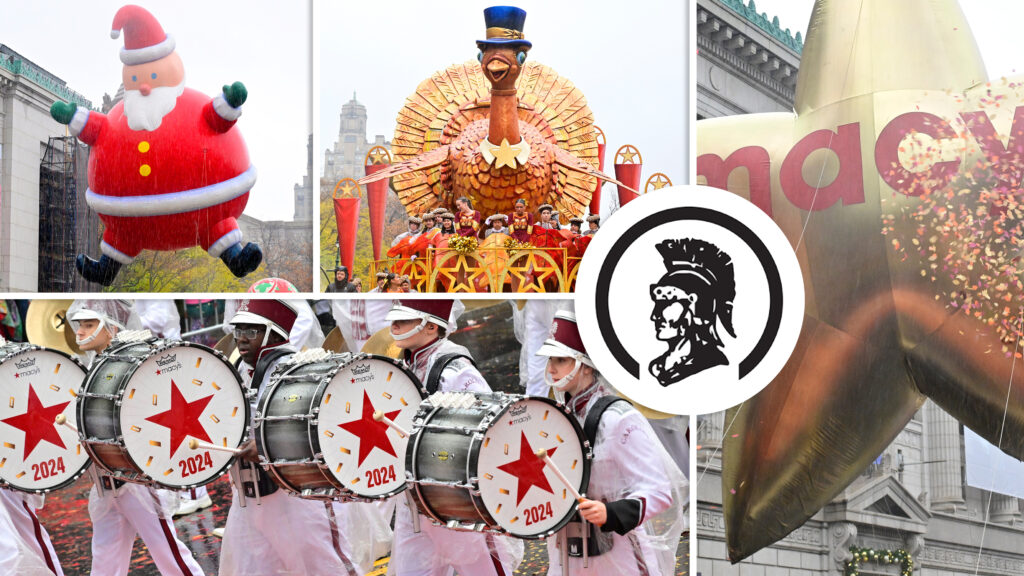The 2012 Drum Corps International Tour celebrated 40 years as corps made their way to Lucas Oil Stadium in Indianapolis to wrap up the season.
The World Championship Finals competition ended as it did 14 times before, with Blue Devils picking up another title with the corps’ “Café Voltaire” production. In second place Carolina Crown took home the brass caption award with its show based on Copland’s “Fanfare for the Common Man,” topping Phantom Regiment’s third-place “Turandot” production.
In fourth place The Cadets explored the wonders of the Christmas season with “12.25,” and if there was a “Happy to Be There” award in 2012, it would undoubtedly have been presented to the Crossmen. The San Antonio corps appeared as a top-12 finalist for the first time since 2004, ending the Blue Stars’ four-year Finals streak by just three tenths of a point in the Semifinals.
Many referred to Boston Crusaders’ seventh-place production, “The Titans” as being “old school,” as the show did not forsake the type of raw, emotional power that people had come to expect from the corps.
The organization’s design staff members worked to infuse it with an emotional angst and a sense of retribution against those holding back the Titan characters. Without a doubt, Boston had a good handle on how to do retribution, and while the show often projected a sense of anger, it was also imbued with a sense of justice and glory.
The corps played to this theme from the get-go, taking the field for performance with one of the most epic entrances ever. A brief and plaintively slow introduction to the first movement of Gustav Mahler’s “Symphony No. 1” initiated the production, performed by two brass players who started on the field accompanied only by a drone from the front ensemble.

A palpable tension released as the members of the horn line poured through the four entrance tunnels of Indianapolis’ modern coliseum to the strains of Ottorino Respighi’s “Pines of the Appian Way.” This final movement his 1924 “Pines of Rome” suite represented ancient legions of Roman soldiers marching into the city after a great military triumph.
As soon as the announcer officially introduced the corps, the brass players, now scattered across the field, formed a straight line and turned to the front as flags of regal purple popped up. The opener segment titled “Celebration” commenced with another movement from Respighi’s suite, the opening of “Pines of the Villa Borghese.”
Bright flags of yellow, gold, and red replaced the color guard section’s purple silks as the mellophones took center stage with an extremely exposed feature. Sandwiched in between this and a percussion break was a four-bar quote from Respighi’s 1916 “Trevi Fountain at Noon.” To end this segment, the horn line moved into a double column down the 50-yard line, ending in threatening battle poses directed at those standing in the opposite column.
A militaristic percussion interlude based on the stabbing chords and ominous chorale from “Circuses,” the first movement of Respighi’s 1928 “Roman Festivals” written to convey an ancient gladiatorial battle to the death, introduced the corps’ segment titled “Ritual.” This part also included the beginning of the fourth movement of Dmitri Shostakovich’s “Symphony No. 10.” A baritone soloist performed the original oboe solo as a large five-yard wide maroon tarp got pulled out from the front sideline, extending almost to the center of the field.
“Ritual” evolved into an eerie chorale of “Evey Reborn,” written by Italian composer Dario Mariancelli for the 2006 “V for Vendetta” soundtrack which built to a searing, wailing brass statement as female guard members frantically swung double maroon flags. The male members of the guard, dressed in centurion-inspired breastplates, expressed the agony of battle; some while carrying others slumped over their shoulders.
The fast-paced whirlpool of Respighi’s heatedly enthused “War Dance” from the 1932 ballet, “Belkis, Queen of Sheba,” provided the sole selection for Boston’s fourth segment, “Titanomachy,” with the bugle calls of the corps’ iconic “Conquest” heard at the end.
The show concluded with “Return to the Hall of the Gods,” based on the fourth and final moment of Mahler’s “Symphony No. 1.” A gallant company front and two large arcs of horns preceded several lines passing through each other. A final company front brought the show to its ending heroically declaring victory of the titans over one’s adversaries.

Michael Boo was a member of the Cavaliers from 1975-1977. He has written about the drum corps activity for more than 35 years and serves as a staff writer for various Drum Corps International projects. Boo has written for numerous other publications and has published an honors-winning book on the history of figure skating. As an accomplished composer, Boo holds a bachelor's degree in music education and a master's degree in music theory and composition. He resides in Chesterton, Indiana.





